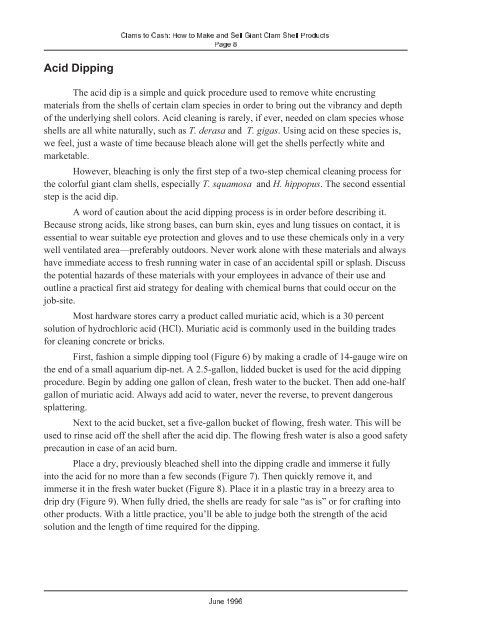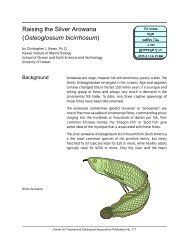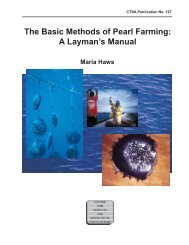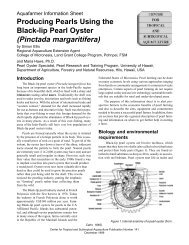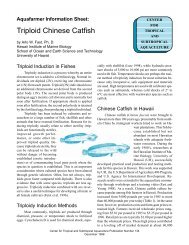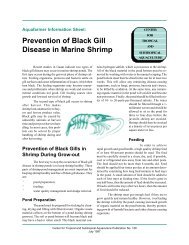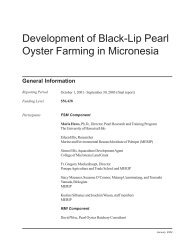Clams to Cash: How to Make and Sell Giant Clam Shell ... - eXtension
Clams to Cash: How to Make and Sell Giant Clam Shell ... - eXtension
Clams to Cash: How to Make and Sell Giant Clam Shell ... - eXtension
- No tags were found...
Create successful ePaper yourself
Turn your PDF publications into a flip-book with our unique Google optimized e-Paper software.
<strong><strong>Clam</strong>s</strong> <strong>to</strong> <strong>Cash</strong>: <strong>How</strong> <strong>to</strong> <strong>Make</strong> <strong>and</strong> <strong>Sell</strong> <strong>Giant</strong> <strong>Clam</strong> <strong>Shell</strong> ProductsPage 8Acid DippingThe acid dip is a simple <strong>and</strong> quick procedure used <strong>to</strong> remove white encrustingmaterials from the shells of certain clam species in order <strong>to</strong> bring out the vibrancy <strong>and</strong> depthof the underlying shell colors. Acid cleaning is rarely, if ever, needed on clam species whoseshells are all white naturally, such as T. derasa <strong>and</strong> T. gigas. Using acid on these species is,we feel, just a waste of time because bleach alone will get the shells perfectly white <strong>and</strong>marketable.<strong>How</strong>ever, bleaching is only the first step of a two-step chemical cleaning process forthe colorful giant clam shells, especially T. squamosa <strong>and</strong> H. hippopus. The second essentialstep is the acid dip.A word of caution about the acid dipping process is in order before describing it.Because strong acids, like strong bases, can burn skin, eyes <strong>and</strong> lung tissues on contact, it isessential <strong>to</strong> wear suitable eye protection <strong>and</strong> gloves <strong>and</strong> <strong>to</strong> use these chemicals only in a verywell ventilated area—preferably outdoors. Never work alone with these materials <strong>and</strong> alwayshave immediate access <strong>to</strong> fresh running water in case of an accidental spill or splash. Discussthe potential hazards of these materials with your employees in advance of their use <strong>and</strong>outline a practical first aid strategy for dealing with chemical burns that could occur on thejob-site.Most hardware s<strong>to</strong>res carry a product called muriatic acid, which is a 30 percentsolution of hydrochloric acid (HCl). Muriatic acid is commonly used in the building tradesfor cleaning concrete or bricks.First, fashion a simple dipping <strong>to</strong>ol (Figure 6) by making a cradle of 14-gauge wire onthe end of a small aquarium dip-net. A 2.5-gallon, lidded bucket is used for the acid dippingprocedure. Begin by adding one gallon of clean, fresh water <strong>to</strong> the bucket. Then add one-halfgallon of muriatic acid. Always add acid <strong>to</strong> water, never the reverse, <strong>to</strong> prevent dangeroussplattering.Next <strong>to</strong> the acid bucket, set a five-gallon bucket of flowing, fresh water. This will beused <strong>to</strong> rinse acid off the shell after the acid dip. The flowing fresh water is also a good safetyprecaution in case of an acid burn.Place a dry, previously bleached shell in<strong>to</strong> the dipping cradle <strong>and</strong> immerse it fullyin<strong>to</strong> the acid for no more than a few seconds (Figure 7). Then quickly remove it, <strong>and</strong>immerse it in the fresh water bucket (Figure 8). Place it in a plastic tray in a breezy area <strong>to</strong>drip dry (Figure 9). When fully dried, the shells are ready for sale “as is” or for crafting in<strong>to</strong>other products. With a little practice, you’ll be able <strong>to</strong> judge both the strength of the acidsolution <strong>and</strong> the length of time required for the dipping.June 1996


